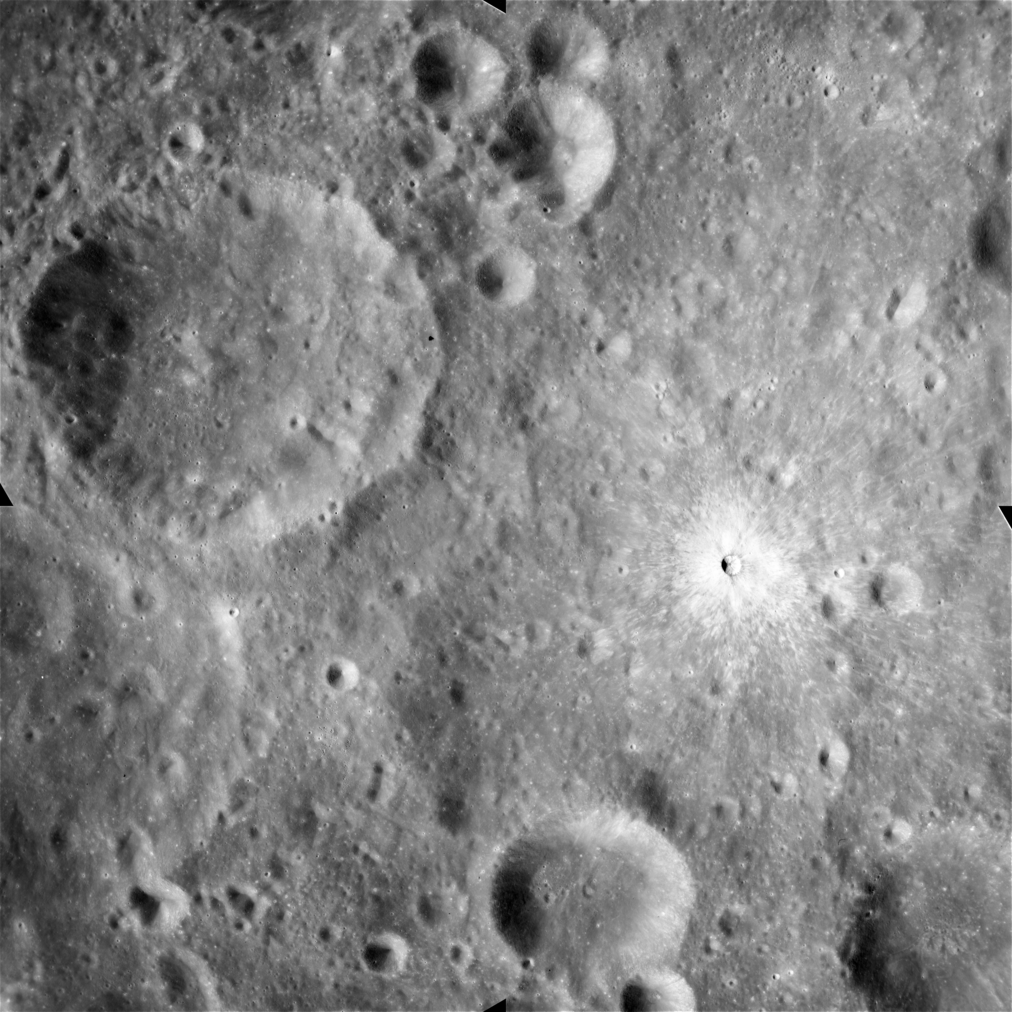
| Project Home | About the Scans | Browse Gallery | Image Map | Support Data | Resources | Ephemeris |
Featured Image - 05/06/2008
Bright, Fresh Craters and Space Weathering
Apollo 15 metric mapping image AS15-M-0103 was acquired on the lunar farside and shows an area west of Gagarin and Isaev Crater. Clearly visible on the right side of this image is a small, bright, fresh crater (Figure 1).
Figure 1: Small, bright, fresh crater west of Isaev and Gagarin Craters.
(Apollo Image AS15-M-0103 [NASA/JSC/Arizona State University])
Why is this crater so much brighter than the surrounding materials?
The upper few meters of the lunar surface is called the regolith and is a product of repeated impacts throughout the Moon's history. On the Moon, there is no wind or water to weather these surface materials, but the interaction with the space environment causes a different kind of alteration called "space weathering". Space weathering is the interaction between the surface of a planetary body like the Moon (or asteroids) and the space environment, including the solar wind and micrometeorites. The solar wind includes charged subatomic particles (like electrons and protons) ejected from the Sun's corona. The solar wind causes radiation sputtering at the lunar surface and implants solar wind particles into the lunar surface.
When micrometeorites impact the surface of the Moon at high speeds, they cause melting, volitilization, and the formation of agglutinates. Agglutinates are tiny, oddly-shaped pieces of impact-fused glass containing small metal, mineral, and rock particles. The high speed of micrometeorite impacts (about 20 km/s) on the lunar surface means these impacts have enough energy to turn the impacted rock fragments into vapor. These rock fragments are in turn composed of silicate-bearing minerals, like olivine and pyroxene, that contain iron. The impact volitilization process reduces the iron in these rock fragments into a thin (often only nanometers thick) metallic iron film that coats the individual components of the lunar regolith. This submicroscopic iron, or SMFe, plays a huge role in changing the optical properties of the lunar surface.
The collective effect of all of the various space weathering processes is to darken the lunar surface. The Earth is protected from the solar wind by its magnetosphere and from micrometeorites by its atmosphere, but the Moon does not have any protection. Thus, lunar surface materials are exposed to the solar wind and micrometeorites, and the older the surface the more time it has had to be darkened by the effects of space weathering and micrometeorites. So, when an impact excavates material from depth, it ejects younger, fresher material that has not yet been space weathered, as is the case for the small crater west of Isaev.
Bright, fresh craters like this will be high priority targets for the upcoming Lunar Reconnaissance Orbiter Camera, as the ejecta materials around the crater provide windows into the subsurface and are relatively unaffected by space weathering.
For more information about space weathering on the lunar surface, please read:
Planetary Science Research Discoveries: New Mineral Proves an Old Idea about Space Weathering
Tweet
![]()

|
|
Space Exploration Resources |
|
 LPI LPI
|
